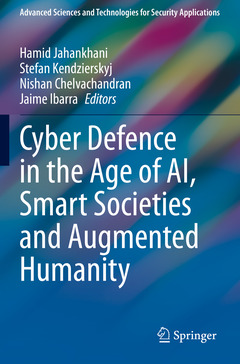Cyber Defence in the Age of AI, Smart Societies and Augmented Humanity, 1st ed. 2020 Advanced Sciences and Technologies for Security Applications Series
Coordonnateurs : Jahankhani Hamid, Kendzierskyj Stefan, Chelvachandran Nishan, Ibarra Jaime

This publication highlights the fast-moving technological advancement and infiltration of Artificial Intelligence into society. Concepts of evolution of society through interconnectivity are explored, together with how the fusion of human and technological interaction leading to Augmented Humanity is fast becoming more than just an endemic phase, but a cultural phase shift to digital societies. It aims to balance both the positive progressive outlooks such developments bring with potential issues that may stem from innovation of this kind, such as the invasive procedures of bio hacking or ethical connotations concerning the usage of digital twins. This publication will also give the reader a good level of understanding on fundamental cyber defence principles, interactions with Critical National Infrastructure (CNI) and the Command, Control, Communications and Intelligence (C3I) decision-making framework. A detailed view of the cyber-attack landscape will be garnered; touching on thetactics, techniques and procedures used, red and blue teaming initiatives, cyber resilience and the protection of larger scale systems. The integration of AI, smart societies, the human-centric approach and Augmented Humanity is discernible in the exponential growth, collection and use of [big] data; concepts woven throughout the diversity of topics covered in this publication; which also discusses the privacy and transparency of data ownership, and the potential dangers of exploitation through social media. As humans are become ever more interconnected, with the prolificacy of smart wearable devices and wearable body area networks, the availability of and abundance of user data and metadata derived from individuals has grown exponentially. The notion of data ownership, privacy and situational awareness are now at the forefront in this new age.
Jahankhani's principal research area for a number of years has been in the field of cyber security, information security and digital forensics. In partnership with the key industrial sectors, he has examined and established several innovative research projects that are of direct relevance to the needs of UK and European information security, digital forensics industries, Critical National Infrastructure and law enforcement agencies. Hamid have planned, proposed and managed several collaborative projects, and secured a substantial research income of up to £6m.
Jahankhani is the Editor-in-Chief of the International Journal of Electronic Security and Digital Forensics, www.inderscience.com/ijesdf, International Journal of Electronic democracy, www.inderscience.com/ijed, both published by Inderscience and general chair of the annual International Conference on Global Security, Safety and Sustainability (ICGS3). He has edited and contributed to over 15 books and has over 150 conference and journal publications together with Various BBC radio interviews. Jahankhani has supervised to completion 13 PhD and professional doctorate degree students and overseen 67 PhD students progressing. In summer 2017 Jahankhani was trained as the GCHQ “cyberist” to train the next generation of cyber security experts through GCHQ CyberFirst initiative.
Stefan Kendzierskyj is an experienced commercial director with over 25 years gained with a numberof
Date de parution : 04-2021
Ouvrage de 450 p.
15.5x23.5 cm
Date de parution : 04-2020
Ouvrage de 450 p.
15.5x23.5 cm
Disponible chez l'éditeur (délai d'approvisionnement : 15 jours).
Prix indicatif 168,79 €
Ajouter au panier


